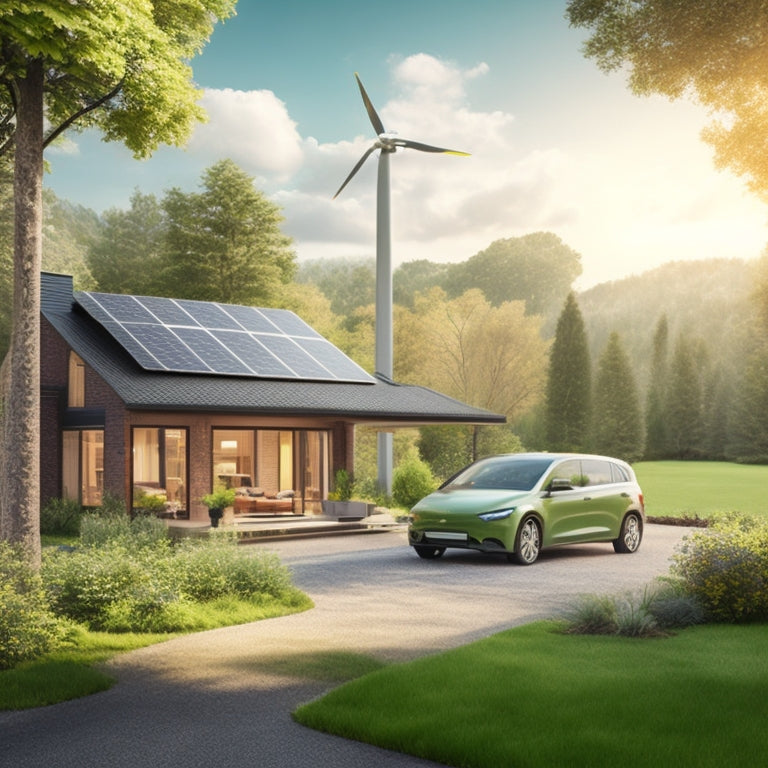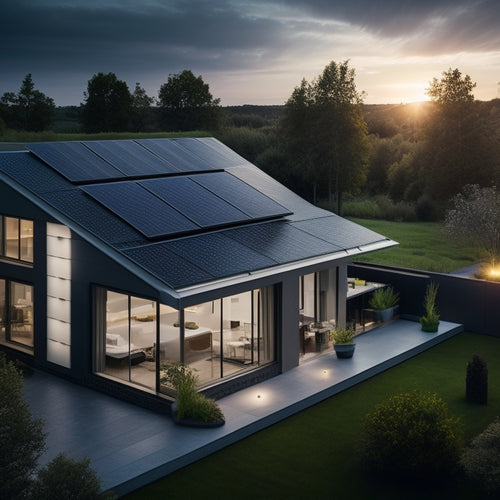
7 Steps to Home Energy Freedom
Share
You're on the path to achieving home energy freedom by following these 7 steps. First, assess your energy needs by tracking utility bills and calculating daily energy requirements. Next, optimize your home's envelope by sealing air leaks, insulating walls, and upgrading windows. Then, upgrade to energy-efficient appliances and utilize renewable energy sources like solar panels. Implement energy-saving technologies, such as smart thermostats and LED lighting, and monitor your progress with real-time data. By following these steps, you'll be well on your way to energy independence and a reduced carbon footprint. Now, examine each step in more detail to uncover the secrets to accessing your home's full energy potential.
Overview
- Assessing energy needs through utility bills and energy audits helps homeowners determine their daily energy requirements in watt-hours.
- Sealing air leaks, insulating walls, and upgrading windows are crucial steps in optimizing a home's envelope for energy efficiency.
- Upgrading to energy-efficient appliances and harnessing renewable energy sources like solar power can significantly reduce energy dependence.
- Conducting a home energy audit identifies areas for improvement and establishes a baseline for future energy consumption comparisons.
- Implementing energy-saving technologies like smart thermostats and LED lighting, and monitoring progress, helps homeowners achieve home energy freedom.
Assess Your Energy Needs
Most homeowners underestimate their energy needs, which can lead to inefficient systems and higher energy bills.
You're not alone if you're unsure about your energy consumption. To gain control, start by tracking your utility bills over the past year. Identify patterns and peak usage periods, such as winter or summer. This will help you determine your average energy consumption.
Calculating daily energy requirements in watt-hours (Wh) for all appliances and systems, and conducting an energy audit, will guarantee your renewable energy system meets your energy needs load calculations.
Next, consider your lifestyle and habits. Do you work from home or have a large family? These factors impact your energy needs.
By understanding your energy requirements, you can make informed decisions about your energy systems, reducing waste and saving you money.
Take the first step towards home energy freedom by evaluating your energy needs today.
Optimize Your Home's Envelope
You'll be surprised at how much energy escapes through air leaks, inefficient insulation, and outdated windows.
To optimize your home's envelope, you'll need to seal those air leaks, insulate your walls properly, and upgrade your windows efficiently.
By investing in renewable energy storage solutions, such as deep cycle batteries and lithium-ion energy storage systems, you can further reduce your energy reliance and enhance energy independence.
Seal Air Leaks Now
As you take the first step towards home energy freedom, it's essential to seal air leaks now and optimize your home's envelope. Air leaks can greatly impact your energy bills and air quality.
When heated or cooled air escapes through gaps and cracks, your HVAC system works harder, increasing your energy consumption. Additionally, airborne pollutants and moisture can infiltrate your home, compromising indoor air quality.
According to Energy Efficiency Technologies, automated temperature control can optimize energy usage based on schedules, reducing peak energy consumption and leading to cost savings. In addition, energy-efficient smart thermostats can enhance comfort while reducing carbon footprints.
To get started, inspect your home's exterior and interior for gaps around windows, doors, electrical outlets, and switches. Use caulk, spray foam, or weatherstripping to seal these areas.
Insulate Walls Properly Today
By now, you've sealed the air leaks, and it's time to tackle the next crucial step in optimizing your home's envelope: insulating your walls properly.
Proper insulation techniques can make a significant difference in your energy consumption. Insulation acts as a barrier, preventing heat from escaping in the winter and entering in the summer. This reduces your reliance on heating and cooling systems, saving you money on energy bills.
The benefits of insulation don't stop there - it also reduces noise pollution, increases your home's comfort level, and even enhances its resale value.
To get started, identify areas in your walls that need insulation, and choose the right materials for the job.
With proper insulation, you'll be one step closer to achieving home energy freedom.
Upgrade Windows Efficiently
Every third home in the United States suffers from inefficient windows, which can account for up to 30% of your home's heat loss in winter and heat gain in summer.
Upgrading your windows efficiently is vital to achieving home energy freedom. You'll want to choose the right window materials, such as energy-efficient glass, vinyl, or fiberglass frames, and consider factors like U-factor, solar heat gain coefficient, and air leakage.
Proper installation techniques are also important, including ensuring airtight seals, flashing, and insulation around the window frame.
By upgrading your windows, you'll reduce heat transfer, minimize air leaks, and enjoy a more comfortable, energy-efficient home.
With the right windows and installation, you'll be one step closer to breaking free from energy dependence.
Insulate and Seal Air Leaks
You'll be surprised at how much energy you're losing through gaps and cracks in your home's envelope.
By sealing these air leaks, you can greatly reduce heat loss in the winter and heat gain in the summer.
Start by inspecting your home's exterior and interior for openings around windows, doors, electrical outlets, and switches, and then seal them with caulk, spray foam, or weatherstripping.
Seal Gaps and Cracks
As you walk through your home, you mightn't notice the tiny gaps and cracks in the walls, floors, and ceilings, but they can quietly sabotage your energy efficiency efforts.
To seal these gaps, start by conducting a home inspection to identify areas where air is escaping. Use weather stripping around doors and windows, and apply caulking techniques to fill gaps in walls and floors.
Don't forget to use draft stoppers under doors and consider foam sealant for larger gaps. During an energy audit, thermal imaging can help detect hidden air leaks.
Make certain proper ventilation systems are in place to maintain healthy air pressure. By filling these gaps, you'll be one step closer to achieving home energy freedom.
Reduce Heat Loss
Efficiency takes a hit when warmth seeps out of your home, making it essential to reduce heat loss. Insulation is key to keeping the heat in.
Check your attic, walls, and floors for adequate insulation. Don't forget to seal air leaks around windows, doors, and electrical outlets.
Thermal bridging, where heat escapes through gaps in insulation, can be a major culprit. Consider hiring a professional to conduct an energy audit to identify areas of heat loss.
They'll use specialized equipment to detect even the slightest temperature differences. By addressing these issues, you'll not only reduce your energy bills but also enjoy a cozier, more comfortable living space.
Upgrade to Energy-Efficient Appliances
One of the simplest ways to cut your energy bills is to upgrade to energy-efficient appliances. Not only will you reduce your energy consumption, but you'll also benefit from energy-saving incentives.
When you invest in energy-efficient appliances, you're investing in appliance longevity. These appliances are built to last, reducing the need for frequent replacements.
Look for the ENERGY STAR label, which indicates that the product meets energy efficiency standards set by the U.S. Environmental Protection Agency. By making the switch, you'll be taking a significant step towards home energy freedom.
Start by replacing your most frequently used appliances, such as your refrigerator, washing machine, and dishwasher. You'll be amazed at the difference it makes in your energy bills and the environment.
Harness Renewable Energy Sources
Your home's energy freedom can be greatly enhanced by utilizing renewable energy sources, which not only reduce your reliance on the grid but also lower your carbon footprint.
You can investigate solar panel installation, wind turbine options, and geothermal heating to generate clean energy. To guarantee a stable supply, consider battery storage solutions.
Renewable energy incentives can also help offset the initial investment. By leveraging renewable energy, you're taking a significant step towards energy independence.
Conduct a home energy audit to identify areas for improvement and develop sustainable energy practices. With the right strategy, you can break free from the grid and enjoy the freedom that comes with producing your own clean energy.
Implement Energy-Saving Technologies
As you strive for home energy freedom, incorporating energy-saving technologies into your daily life can markedly reduce your energy consumption and reliance on the grid.
A great place to start is by conducting an energy audit to identify areas of inefficiency in your home. This will help you pinpoint where energy is being wasted and provide a roadmap for improvement.
From there, consider investing in smart thermostats that can learn your schedule and preferences to optimize heating and cooling.
You can also investigate other energy-saving technologies like LED lighting, power strips, and energy-efficient appliances.
Monitor and Adjust Your Progress
Tracking your progress is essential to achieving home energy freedom.
You've implemented energy-saving technologies, now it's time to monitor and adjust your progress. Invest in energy monitoring systems that provide real-time data visualization, allowing you to track your energy usage and identify areas for improvement.
Set efficiency benchmarks and goals, and regularly analyze your performance to guarantee you're on track. Create feedback loops to make behavioral adjustments as needed.
Frequently Asked Questions
Can I Still Use My Existing HVAC System With Renewable Energy?
You can definitely integrate your existing HVAC system with renewable energy sources, ensuring a seamless shift; in fact, many HVAC systems are designed to be compatible with renewable energy integration, allowing you to utilize clean power efficiently.
How Do I Prioritize Energy-Efficient Upgrades on a Limited Budget?
You're on a mission to prioritize energy-efficient upgrades, but where do you start? Begin with an energy audit to identify areas of improvement, then create a budget plan that tackles the most critical issues first, maximizing your limited budget's impact.
Will Energy-Efficient Appliances Affect Their Performance or Lifespan?
You're wondering if energy-efficient appliances will compromise performance or lifespan. Rest assured, they're designed to provide energy savings without sacrificing appliance durability, so you can enjoy guilt-free convenience and a clear conscience.
Can I Install Solar Panels on an Old or Historic Home?
As you commence on a quest to utilize the sun's power, you'll find that installing solar panels on your old or historic home is like polishing a treasured heirloom - it requires careful consideration of solar panel compatibility and historic preservation concerns to guarantee a harmonious blend of past and present.
Are There Any Government Incentives for Home Energy Upgrades?
You're eligible for government incentives like rebate programs and tax credits when upgrading your home's energy efficiency, offsetting costs and enhancing savings; research and claim these benefits to maximize your investment and gain energy independence.
Ready to Buy
You've taken the first step towards home energy freedom, and now you're standing at the threshold of a brighter future. Imagine the weight of energy bills lifting off your shoulders like a bird taking flight. As you implement these 7 steps, envision your home evolving into a self-sustaining oasis, where energy efficiency and renewable power converge. With every switch flipped and every panel installed, you're weaving a fabric of independence, thread by thread. The light at the end of the tunnel is yours to claim.
Related Posts
-

Renewable Energy Solutions to Reduce Your Carbon Footprint
To reduce your carbon footprint, adopting renewable energy solutions is key. Using solar panels or wind turbines can ...
-

Home Solar Battery
You're opting for a home solar battery that allows you to utilize the power of the sun during the day and use it at n...
-

Top Solar Powered Camping Fans for Camping Enthusiasts
If you're a camping enthusiast, a solar-powered fan can be a transformative element for your outdoor experience. Thes...


